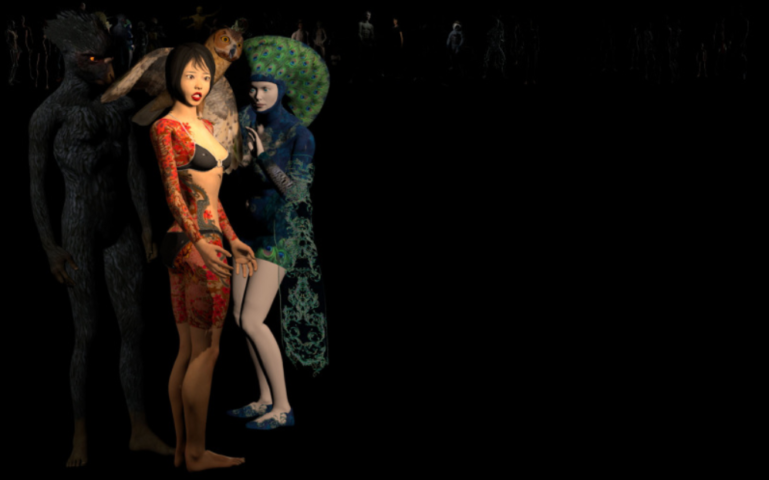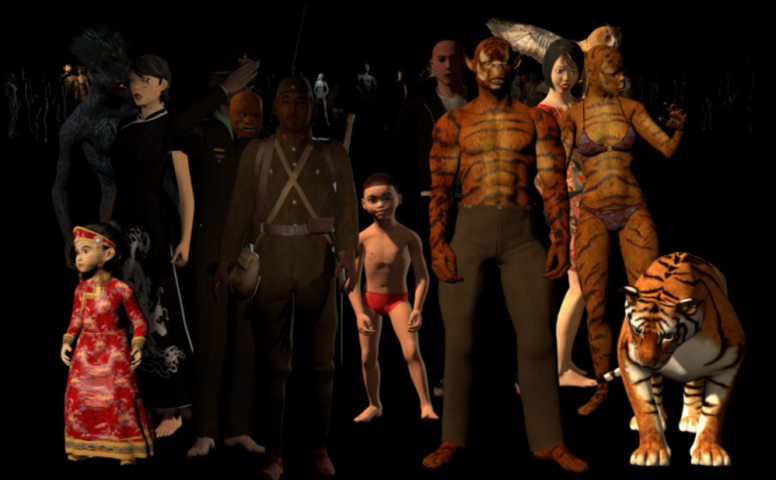



Arthub Favorite: Week 76, In Conversation with Ho Tzu Nyen
Singaporean artist Ho Tzu Nyen has a new show at the Berlin gallery Michael Janssen, called No Man II. We spoke with him about his process, his own conception of his characters as empty shells, and his love for books.
TEXT/Naima Morelli
IMAGES/Couresy of the artist and Galerie Michael Janssen, Berlin
There are artists who make objects and are pretty good at their craft. Then, there are artists whose production allows them to live and work in the art system. Then, there are artists whose work is autobiographical and very much tied to their own lives. And, finally, there are artists whose art is a continuation of their philosophical understanding of the world. For them, technique is nothing less than a direct extension of their mental model.
Singaporean artist Ho Tzu Nyen (b. 1976) belongs to the latter category. His first solo exhibition in Berlin is being held at the gallery Michael Janssen until November 11, 2017. He has presented to the European public a new multimedia installation, entitled No Man II. The whimsical and mysterious work represents a museum of popular imagination of the human figure. Here, we can find characters from both mythology and pop culture. It is a real materialisation of the global collective imaginary.
Ho Tzu Nyen has already come up with an observation that reveals the underlying concept of his entire oeuvre. Indeed, in answering my question about what compelled him to create No Man II, Ho Tzu Nyen explains that we humans fabricate stories in order to try and make sense of things. “It’s always difficult to talk about the genesis of something without fictionalising it,” he says. “I’ll try the best I can, to tell you how the project started.”
His first inspiration came from a poem by John Donne, who he came into contact with as a student, called Devotions upon Emergent Occasions: Meditation XVII, which the artist read as a student. “I reproduced the John Donne poem almost entirely, except for one small change that I made to his text. The poem says that no man is an island, referring to England. Donne says that when a man dies, it is like a part of England is washed away. He alluded to England as being part of Europe. The only change I made to the text was to change the world Europe to Malaya, the old name during the colonial period that described Singapore and Malaysia together. It was when Singapore was kicked out of the Federation of Malaya that our two countries split up, and Singapore became Singapore. Even though No Man II has more to do with a global imagination, the fact that I am situated in Singapore still slips through these little things.”
Indeed, No Man II is a continuation of the video installation No Man, which you first showed in Singapore. In No Man, one could relate to all of the characters’ diversity with the ethnic diversity of Singapore. Does No Man II take on a different meaning when it’s shown in Berlin?
There were 50 figures in No Man because the work was commissioned for the 50th anniversary of Singapore. The Singapore version was 60 minutes long, with six screens, six mirrors. Each figure was in isolation and didn’t overlap with the others. They existed in this black space, an empty place. The figures didn’t have any narrative connection; they didn’t speak to each other or relate to each other. However, if you watch the work for a long time, the figures might look like they are interacting through their gestures and the light. While some figure appeared, others faded. It was almost a theatrical stage. This relationship between the figures became more intense with No Man II. Here, we have a foreground and a background, with a group of figures that can appear or disappear in these two plans. The Berlin version is six hours long.
How did the spectators interact with the video installation?
We projected the work on a two-way mirror, the kind used in police stations for interrogations. You can decide, by using the lighting, which side is a mirror and which side you can look through. The spectator can walk in front of this mirror and also walk to the back. We added two lights on the front; one that is warm and golden, and the other cold and bluish. These switch at topical moments during the song. It relates to the last two lines of the John Donne poem, which say: “Don’t ask for whom the bells tolls, it tolls for thee.” So don’t ask for whom the church bells are ringing, they are always ringing for you. At the moment one of these two lights fade out and the audience see their own reflection amongst all of the digital figures.
Another thread that went into the work was your experience of working with computer graphics and 3D animation. Why did you decide to use computer-generated figures?
Some time ago, I found a website which allowed you to purchase and customise thousands of different figures. I thought the website was used mainly by people who were making computer games or digital pornography. I was quite fascinated with the possibilities of figuration; for me these figures were hollow shells. I combined them with tools from another website that offered human gestures. They had a range of motions that were popular at a certain moment in time, such as zombie movements or particular dance movements, which somehow captured the imagination and tension at that point in time.
In the beginning, the work was a montage of forms and movements that had no possible correlation with each other. I liked to play by putting the movements of a zombie on the body of a child or a robot. Again, I related it to the humanist meaning of the John Donne poem, almost in an ironic way, which became another layer. The poem talked about human connections, but it was spoken by non-human digital figures with very complicated origins.
We can also find this blend of real and mythological figures in one of your most celebrated works: Utama – Every Name In History Is I, which focuses on Singapore’s narrative. You have often pointed out how in contemporary times, historical and mythological figures always serve the need of the present. How did you articulate that in Utama versus No Man II?
A lot of works I’m doing today have lines or threads that came from Utama, which was more or less my first exhibition, the very first film that I made. Compared to No Man II, Utama had a direct relationship to Singaporean history, whereas No Man II stems from this more undefined, global imaginary. At the same time, I always saw all the figures that appear in Utama as being hollow shells. The difference is that all of the historical figures that appeared in Utama were all performed, acted or embodied by the same person, who is actually my friend, Singaporean sound artist Zul Mahmod. It was one body that could manifest different identities, so it was hollow.
That has a direct relationship with No Man II where all of these figures are literally digital hollow shells. They can be used, augmented or possessed for different meanings. My attitude towards human figures in my work is to think about them as puppets that can be manipulated in different ways. This logic of figuration extends to most of my work and to myself as well. I’m talking about a certain kind of emptiness that is always a part of my thinking in relation to figures that appear in my film or videos. That’s why I work with non-actors, because then they are more blank. They don’t act, they don’t dramatise.
Does your fascination with the idea of emptiness come from a personal place for you?
These figures being empty is how I see myself, a figure who is sort of empty. I can transform myself by working with other people. It’s a natural process for me. It’s my perception of human subjectivity. I don’t have great faith in my own interior being. I can see every day that I’m a combination of different people. I don’t mean only through interactions. In fact, I’m always changing, even when I’m not interacting with anyone. Every second, I’m modifying.
You said that most of your inspiration comes from reading, which is a solitary activity. Does this become collective through the process and themes that you represent?
Yes, I plan alone first and then I work with others, which I really enjoy because, of course, I really enjoy human company. However, while reading is physically solitary, mentally you are always in a good company. A book is already the presence of someone else, and every book is made up of many other books. Every one is tied to the literature that came before it, just like every philosophical book is engaged with a number of other philosophical traditions. When you open a book, you feel you are with a multiplicity of others.
About the artist
Ho Tzu Nyen’s artistic practice, which primarily includes film and multichannel installations, explores the construction of historical narratives through images and events such as documentary, theater, art, philosophy, and archival materials. The layers of appropriated and original visual materials converge into complicated meditations on topics such as colonialism in his native Singapore, religion, and even abstract ruminations on concepts such as the cloud. Environments and site responsiveness are also important parts of his work, a recognition of the way a work’s context can alter one’s viewing experience. Singapore’s representative at the 2011 Venice Biennale, Nyen has also participated in the São Paulo Biennial and the Cannes and Sundance film festivals.
About the Author
Naima Morelli is an art writer and curator with a focus on contemporary art from the Asia Pacific region. She has written for ArtsHub, Art Monthly Australia, Art to Part of Culture and Escape Magazine, among others, and she is the author of “Arte Contemporanea in Indonesia, un’introduzione” a book focused on the development of contemporary art in Indonesia. As a curator, her practice revolves around creating meaningful connections between Asia, Europe and Australia.